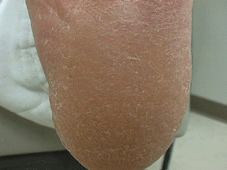
Cracked Heels |
||
What are cracked heels: |
||
Cracked heels are a common foot
problem that are often referred to as heel fissures. Cracked heels
are commonly caused by dry skin (xerosis), and made more complicated
if the skin around the rim of the heel is thick (callus). For most
people this is a nuisance and a cosmetic problem but when the fissures
or cracks are deep, they are painful to stand on and the skin can
bleed - in severe cases this can become infected. |
||
What does a cracked heel look like: |
||
| The skin is normally dry and may have a thick callus which appears as yellow or dark brown discolored area of skin, especially along the inside border of the heel. Cracks in the skin are usually obvious. |
||
 |
 |
|
What are the symptoms of cracked heels: |
||
| If the cracks are bad enough there will be pain on weight bearing, that is not there when weight is off the heel. The edges or rim around the heel will generally have a thicker area of skin (callus). Wearing open or thin soled shoes usually make the symptoms worse. |
||
What causes cracked heels: |
||
| Some people tend to have a naturally dry skin that predisposes them to the cracks. The thickened dry skin (callus) around the heel that is more likely to crack is often due to mechanical factors that increase pressures in that area (eg the way you walk). Other factors that can be involved in the cause of cracked heels include:
|
||
Another way to look at it: Consider a tomato on the bench ... when you push on it from above, it wants to expand out sideways ... eventually the skin cracks. This is what happens to the normal fat pad under your heel ... as your body weight pushes down, the fat wants to expand sideways and the pressure on the skin to crack is increased. If the weight is excessive (eg prolonged standing) and the skin is not supple (eg callus and/or dry) and nothing is helping hold the the fat pad under the foot (eg open backed shoes) ... do you get the picture? |
||
Self treatment for cracked heels: |
||
Applying
an oil based moisturizing cream twice daily is really important
to get on top of this problem. A pumice stone can be used to reduce
the thickness of the hard skin. After looking at the 'tomato' analogy
above it should be obvious why it is important to avoid open backed
shoes or thin soled shoes. Never try to reduce the hard skin your self with a razor blade or a pair of scissors. There is a risk of an infection developing and taking too much off. Check
the sites below to buy products that will help you with self management.
They all have emollients and pumice stones. |
||
Book on Natural Foot Care to help treat the cracked heel. Click here... Other recommended books on foot care: |
||
Podiatric management of cracked heels: |
||
The podiatric treatment of cracked heels may involve the following:
|
||
Links of relevance to cracked heels: |
||
|
Ask a question in the Foot Health Forum about the cracked heel Podiatry Arena's threads on Heel Fissures |
||
Buy products here to help a cracked heel: |
||
USA
& Canada: |
UK
& Europe: |
Australia
& NZ: |
Coming |
||
Return to
foot problem or foot pain page |
||
ePodiatry
is purely a source of information on the cracked heel and should
at no time be considered as replacing the expertise of a health
professional. We recommend seeking professional advice for cracked
heels and all foot problems before embarking on any form of self
treatment or management for the cracked heel. Neither the content
or any other service provided through ePodiatry is intended to be
relied on for medical diagnosis or treatment. Do not delay in seeking
health professional advice for cracked heels because of something
seen on ePodiatry. |
||
©2003.
The information contained on this page about cracked heels is subject
to copyright. No part of the information about the cracked heel
contained on this page be reproduced in any form without the permission
of ePodiatry. |
||
Cracked heels |
||